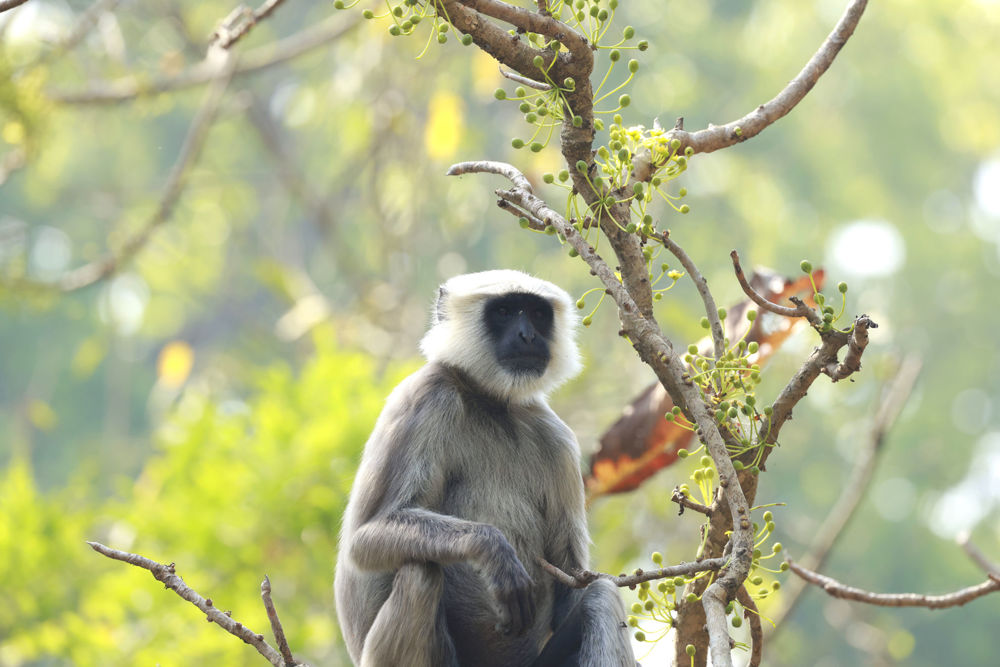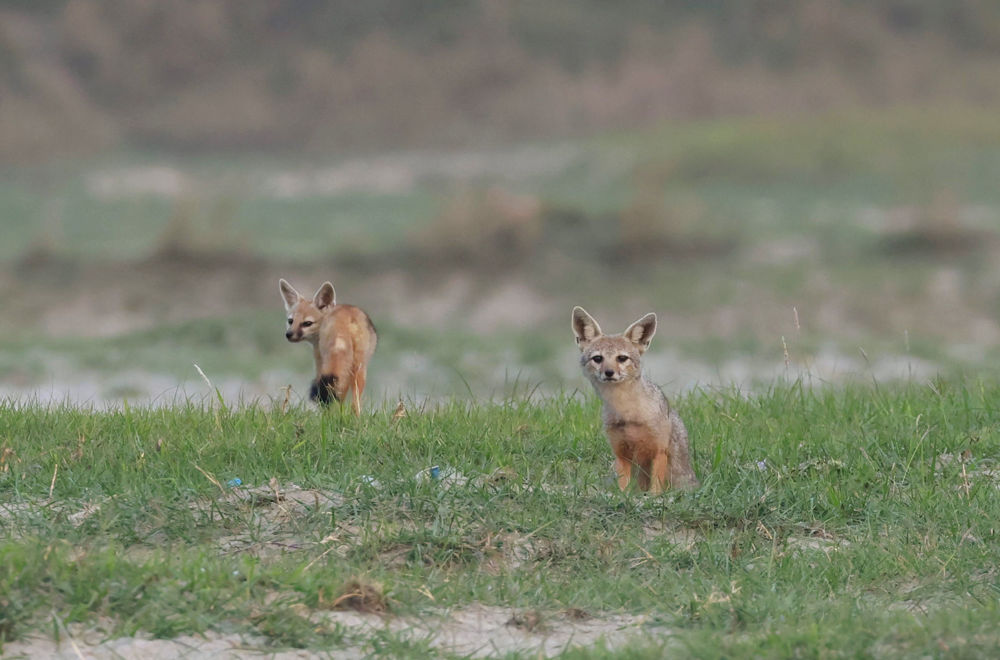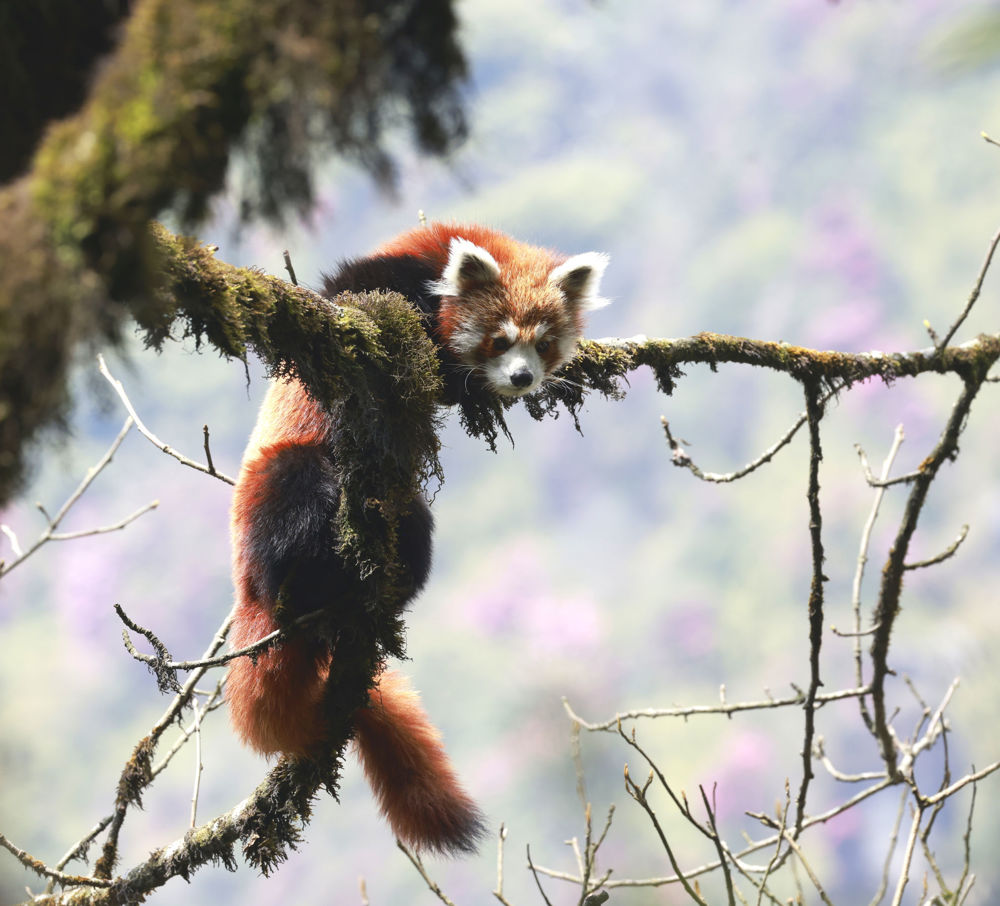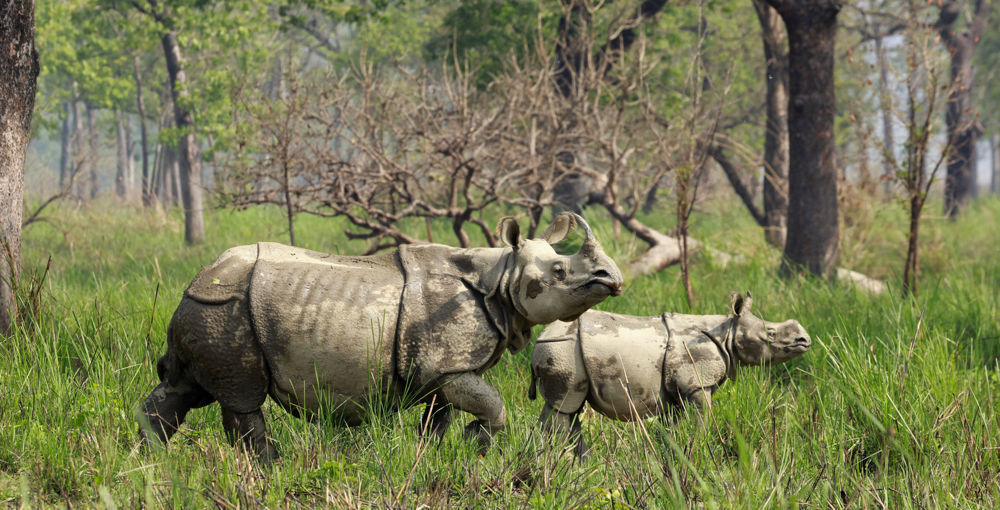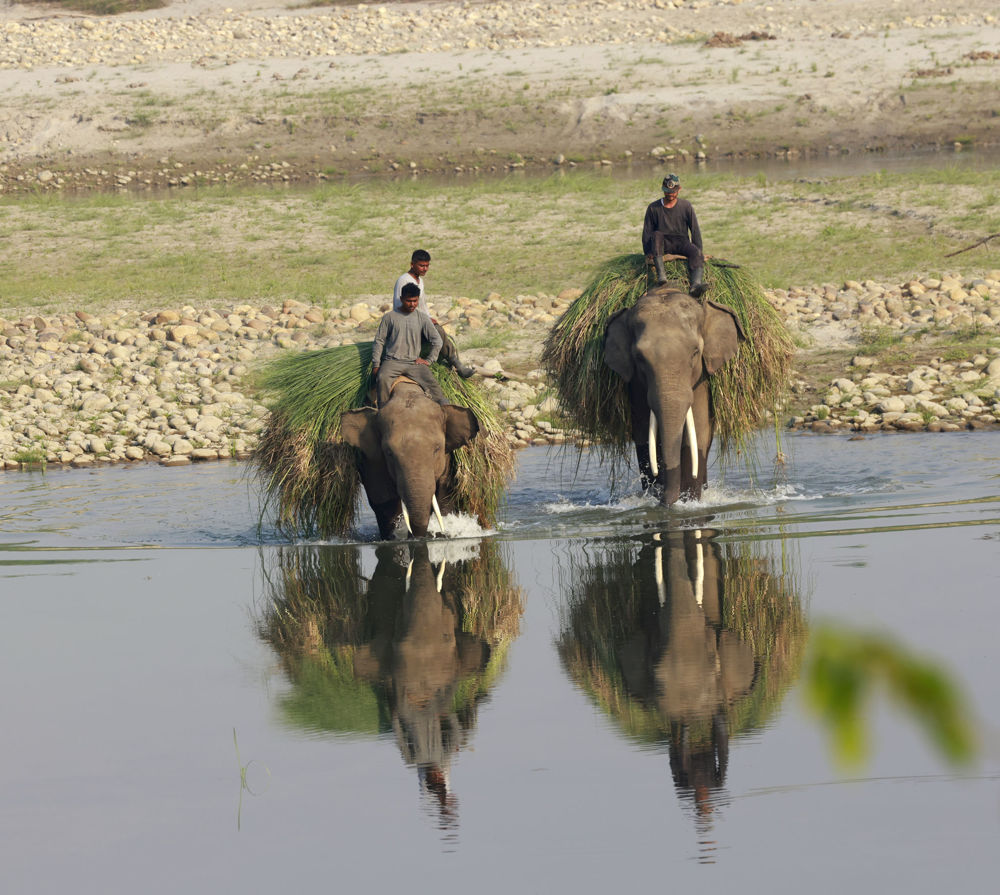Departure Date: April 7 - 27, 2025
Compiled By: Andrew Whittaker
Trip Leaders: Andrew Whittaker, Local Leader
Toll Free: 800.328.8368
Phone: 512.328.5221
Nepal's Himalayan & Tropical Lowland Paradise 4/7/2025-4/27/2025

Another truly outstanding Nepal journey found us exploring two major biomes, where we were rewarded with exceptional wildlife treasures, from spectacular avian gems to big game. We had a blast!
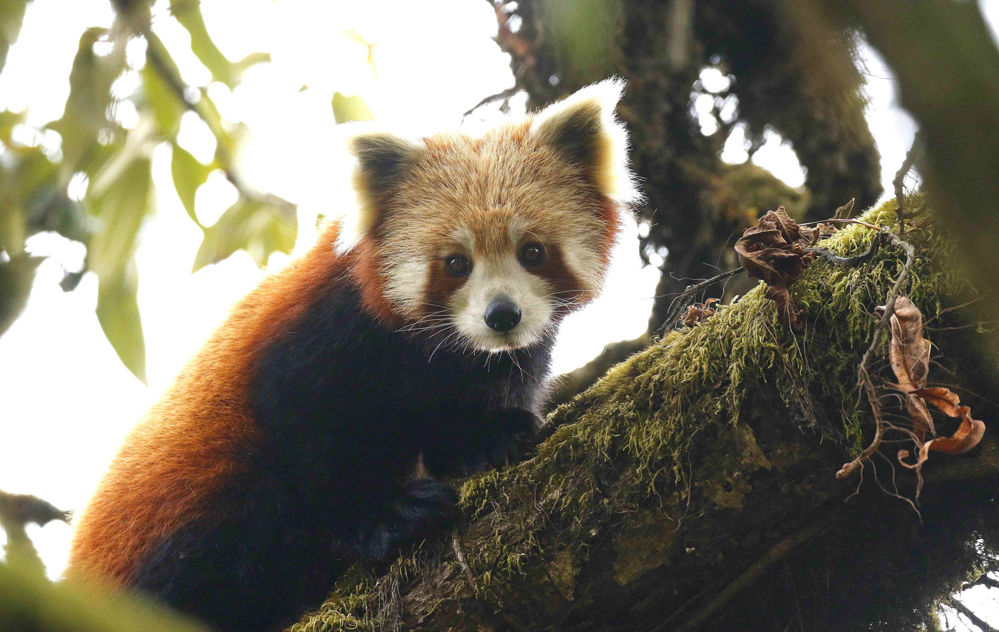
It really is the world’s cutest: the awesome Red Panda—Photo: Andrew Whittaker
Our itinerary, reworked to include famous Chitwan National Park, worked out extremely well. We began on the richly forested slopes of the Himalayan foothills, ablaze with colorful rhododendrons and magnolias; the stupendous scenery included views of Everest. Then we descended to the species-rich tropical lowlands, exploring the mighty Koshi River and Koshi Tappu Reserve wetlands before concluding with exciting jeep safaris through the sal tree forests of Chitwan National Park. Etched firmly in memory will be our remarkable multiple sightings of Red Panda. We also drooled over an incomparable male Satyr Tragopan and the magnificent male Fire-tailed Sunbird, and we enjoyed magical encounters with Indian One-horned Rhino and a huge Sloth Bear with its cub. Nepal never falls short!
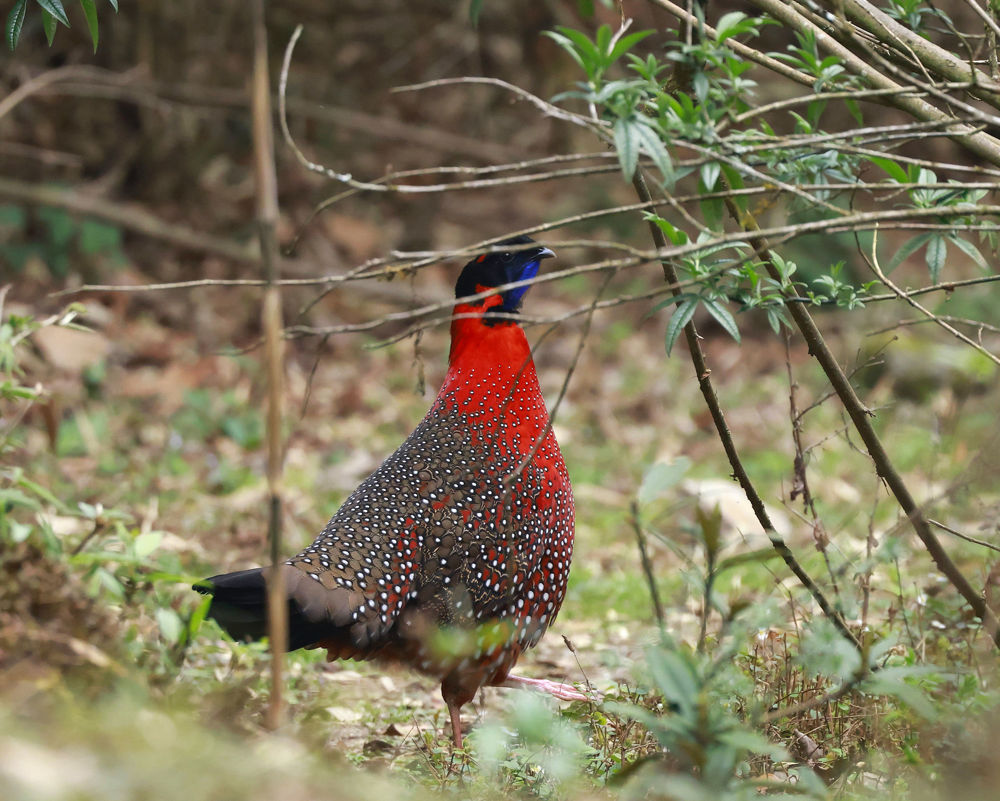
We simply drooled over the incomparable male Satyr Tragopan—Photo: Andrew Whittaker
First and foremost, huge thanks to my friends Som and Badri for helping make this trip a great success by sharing their intimate knowledge of delightful Nepal, its wildlife, and the Jhangad peoples of Koshi.

Roof of the world: the mighty Himalayas and the sleeping Buddha on a pre-dawn excursion—Photo: Andrew Whittaker
We began in bustling Kathmandu, at our fabulous forested retreat in Gokarna. The extensive grounds and golf course, well known as a migrant trap, were a true birder’s delight. Here we were introduced to the Red-billed Blue-Magpie, Common Cuckoo, Blue-throated and Great barbets, Gray-headed Woodpecker, Greater Yellownape, Chestnut-headed Bee-eaters, White-throated Kingfisher, Chestnut-bellied Nuthatch, Scarlet and Long-tailed minivets, Blue-throated Flycatcher, Himalayan Black-lored Tit, Long-tailed Shrike, Rusty-cheeked Scimitar-babblers, Gray Wagtail, and the exquisite Crimson Sunbird. Overhead were migrant Peregrine Falcon, Common Swift, and Siberian Stonechat. And of course we enjoyed the antics of groups of Rhesus Monkeys and herds of Spotted Deer.
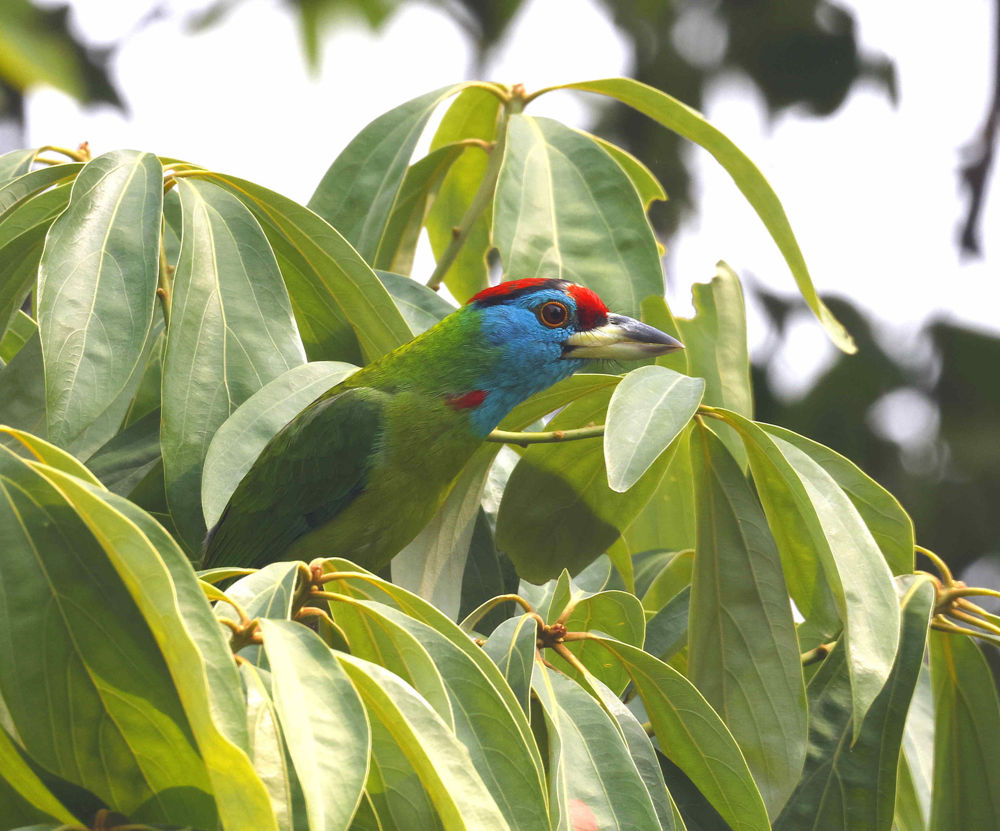
Blue-throated Barbets were common at our hotel—Photo: Andrew Whittaker
A foray into an adjacent dry valley provided us with magnificent male Blue-capped Rock-Thrush, Himalayan Buzzard, Black-throated Tit, White-crested Laughingthrush, and drop-dead views of migrating Steppe Eagles. Sadly, the elusive endemic Spiny Babbler did not show well.
Though our Phulchowki Hills excursion was rainy, we still managed a cool variety of Himalayan specialties, including the Kalij Pheasant, Asian Barred Owlet, Golden-throated Barbet, and others. Best of all, though, was a superb male White-tailed Robin.
Departing bustling Kathmandu, we flew southeast to Bahadrapur, enjoying breathtaking views of the snow-covered Himalayan kingdom. We were met on arrival by the charming Habre’s Nest crew, and full of anticipation, set off in our jeeps.
Passing rice paddies, we soon spotted a wonderfully colorful Indochinese Roller perched on the roadside. The fields were home to striking Red-naped and Black-headed ibis, the huge Lesser Adjutant, Red-wattled Lapwings, Indian Pond-Heron, the odd Asian Openbill, Little Cormorants, and Ashy Woodswallow.
We climbed in elevation through the famous fields of Darjeeling tea before arriving in busy Fikkal with its colorful fruit and vegetable stalls; we enjoyed a scrumptious momo lunch here. Perched Eastern Red-rumped Swallows caught our attention before we continued on the dirt roads through the enchanting foothill forests. A series of birding stops yielded the Mountain Hawk-Eagle, Common Green-Magpie, Plumbeous Redstarts, and Hair-crested Drongo. We passed through rhododendron and oak forests, alpine meadows, and bamboo-dominated forests before arriving at Habre’s Nest.
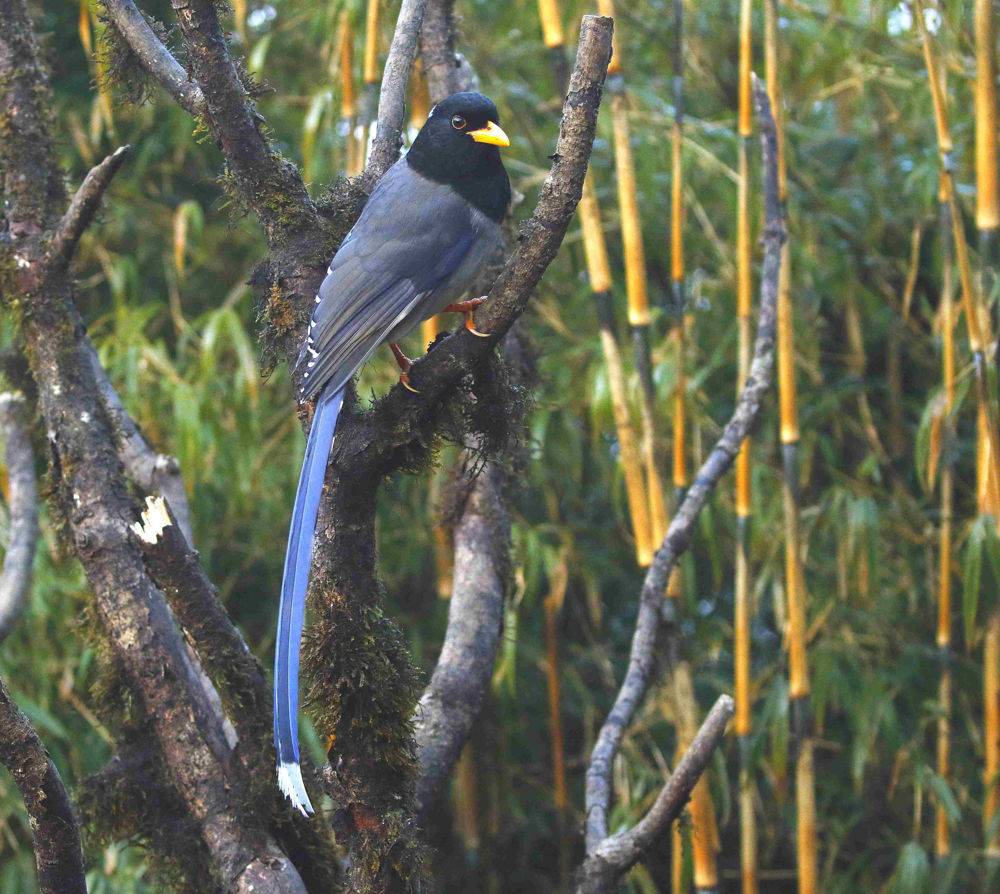
Delightful Yellow-billed Blue-Magpie—Photo: Andrew Whittaker
We spent a marvelous week exploring the enchanting trails and jeep tracks winding through these forests, which are home to many sought-after eastern Himalayan species.
Our first morning started on a high when we found ourselves enjoying a truly unforgettable first sighting of the iconic Red Panda—and this, one of the cutest mammals on our planet, was looking straight back at us! Each time we encountered this enigmatic species, the beautiful rusty color and cute facial markings made us want to cuddle it. Shantanu, one of the world’s leading panda experts, provided us a marvelous insight into their secretive behavior one evening with spectacular video and slides.
Spring in these magnificent foothills was characterized by the evocative calls of our main avian objective, the absolutely incomparable Satyr Tragopan, rightly ranked as one of the world’s most beautiful birds. After some tantalizing views, a stunning male strutted right in front of us. We were spellbound by the spectacular colors and neat spotting of his vibrant scarlet plumage. This breathtaking encounter with one of the world’s true avian greats will forever be imprinted on our minds!
The lodge’s bird blind gave us a privileged opportunity to study at close quarters several shy forest dwellers, especially several laughingthrushes: the incredible line-up here included the much desired and huge Spotted, the dainty Scaly, and the delightful Chestnut-crowned.
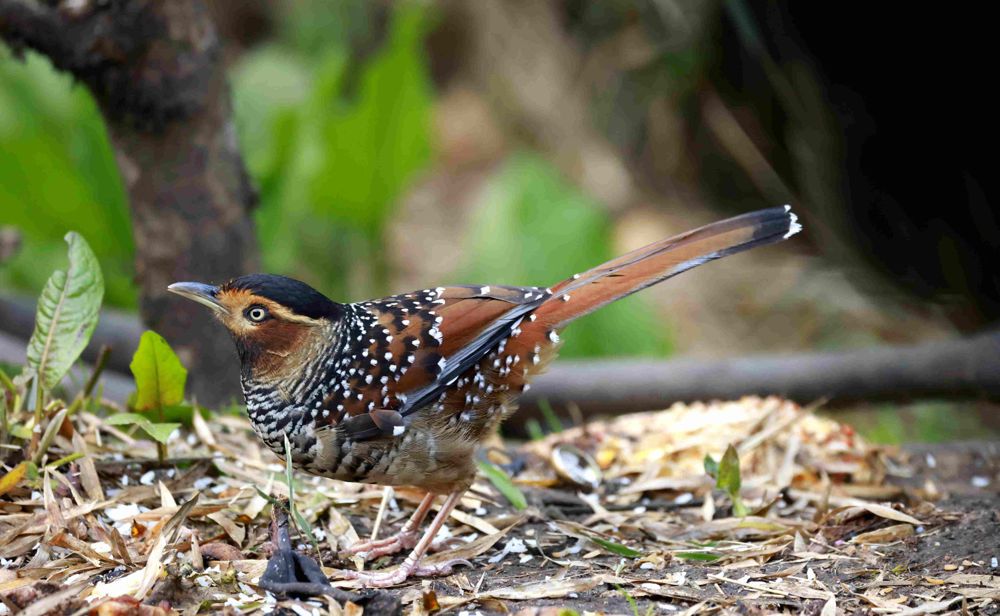
The huge and impressive Spotted Laughingthrush at the lodge’s magical bird blind—Photo: Andrew Whittaker
Other birds of note here were the Blue Whistling-Thrush, Golden Bush-Robin, Oriental Turtle-Dove, Pink-browed Rosefinch, White-browed Fulvetta, and Golden-naped Finch. We were also treated to a delightful family of Yellow-throated Martens, an infrequently seen predator. Stunning Blue-fronted Redstart, Olive-backed Pipit, and a tame pair of Alpine Accentors were regulars around the lodge, as was an impressive Long-tailed Broadbill.
Hiking the network of trails winding through these mysterious forests, we never knew what we might find in the busy mixed flocks. The tree trunks, boughs, and banks were decorated by intriguing mosses, delicate lichens, and colorful primulas. This was the setting for us to find such mouthwatering gems as the Darjeeling Woodpecker, Green-backed and Black-browed tits, Rufous-capped Babbler, Rufous Sibia, White-tailed Nuthatch, Verditer Flycatcher, Himalayan Bluetail, White-browed Bush-Robin, Hoary-throated Barwing, Black-faced Laughingthrush, Chestnut-tailed Minla, Yellow-bellied Fairy-Fantail, Green-tailed Sunbird, and the dazzling Golden-breasted Fulvetta.
Extensive stands of bamboo harbored several other specialists, among them the Himalayan Shortwing, Hume’s Bush-Warbler, and the Slender-billed Scimitar-Babbler. We also tallied several highly desired parrotbills, included fast-moving flocks of tiny Black-throated Parrotbills and the bizarre, almost prehistoric-looking Brown Parrotbill.
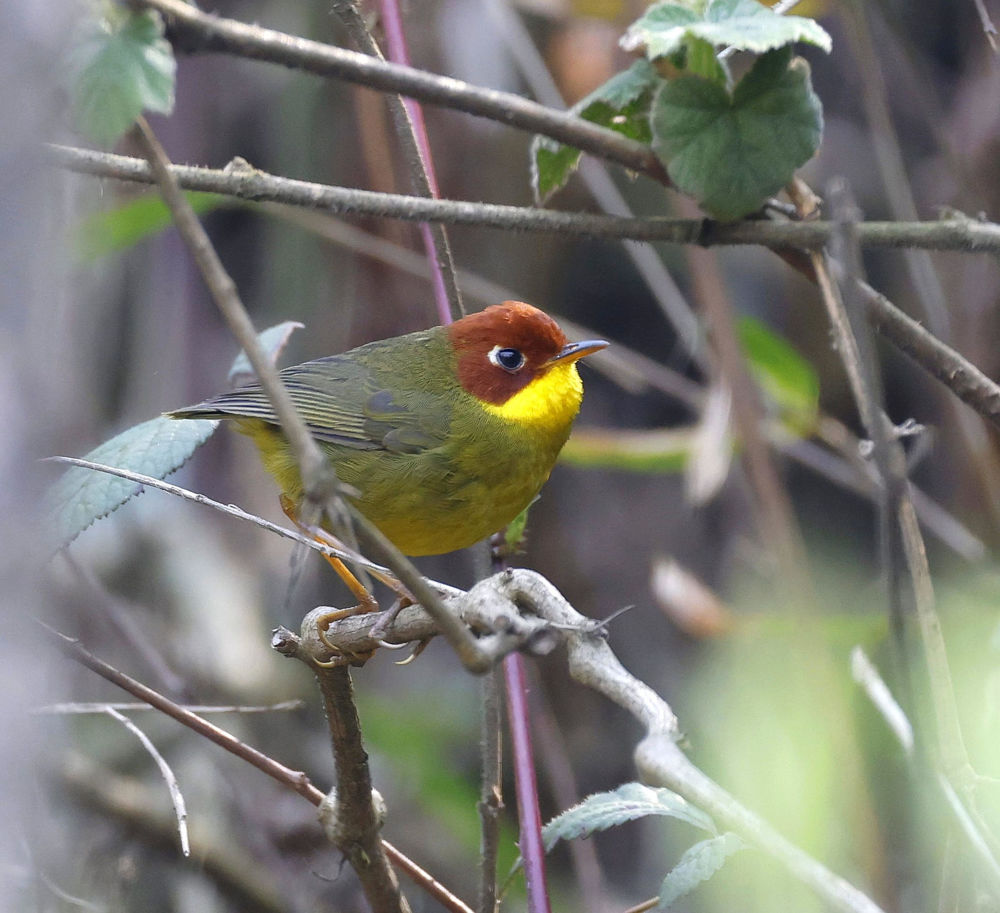
We had excellent studies of the colorful Chestnut-headed Tesia—Photo: Andrew Whittaker
Our highly anticipated excursion to witness sunrise over the top of the world was a great success. Climbing high above the lodge in our Land Cruisers, along countless switchbacks through broadleaf forests, subalpine meadows, and conifer groves, we were greeted by an exhilarating dawn and a jaw-dropping Himalayan vista, featuring four of the five highest peaks in the world, including the mightiest of them all—Everest!
A late migrant male Red-throated Thrush was foraging on the grass while a WOW bird, a spectacular male Fire-tailed Sunbird, distracted us with its mind-blowing iridescence and striking scarlet tail.

The stupendous male Fire-tailed Sunbird—Photo: Andrew Whittaker
Other alpine inhabitants included a glowing male Golden Bush-Robin, White-collared Blackbird, the localized Sikkim Treecreeper, Rufous-vented Tit, Lemon-rumped Warbler, White-browed Bush-Robin, Himalayan Beautiful Rosefinch, and Rufous-breasted Accentor. We could not stop admiring the palette of colors displayed by flowering rhododendrons, marveling at their incredible hues of pink, scarlet, deep red, and white. I even located a rare and endangered Himalayan Goral on a far hillside, and we enjoyed scope views of this rarely seen goat-antelope species.
Bidding farewell to the delightful staff and guides, we retraced our steps. En route we observed a hunting Northern Goshawk, multiple Chestnut-bellied Rock-Thrushes, Pied Bushchat, the magnificent Crested Kingfisher, and Slaty-backed Forktail along the river. Arriving in Fikkal, we met Badri and our vehicles and headed off, stopping for a great meal before visiting a roost of Indian Flying Foxes, followed by snazzy Blue-tailed Bee-eaters in great afternoon light.
At the Barju pools, we quickly located several Greater Painted-Snipe, and enjoyed great scope studies of this sought-after gem. Interesting migrants included a flock of Gray-headed Lapwings and both Temminck’s and Little stints; the crème de la crème were a rare migrant Tibetan Sand-Plover and Marsh Sandpiper. Secluded lily pools held pairs of tiny Cotton Pygmy-Geese, Purple Heron, Little Grebe, striking Gray-headed Swamphens, and smart looking Pheasant-tailed Jacanas.
At Koshi, the staff greeted us with cold fruit juices and cool face towels before we checked into our spacious tents. Birding the lodge’s pools and blinds added Bronze-winged Jacana and White-breasted Waterhen among others.
The next day’s pre-dawn chorus was truly memorable, featuring chuckling Spotted Owlets, howling Golden Jackals, and best of all, the incessant “One more bottle” of the Indian Cuckoo. In the Koshi Reserve and on the floodplains of the Sapta Koshi River (one of the main tributaries of the mighty Ganges), we quickly located one of our main objectives, the highly localized Swamp Francolin; we had good looks at several pairs feeding along the road. A well-constructed tower gave us a panoramic view out over herds of grazing Wild Buffalo. Vocalizing Black Francolins were at first frustrating, but we finally located these colorful gamebirds. We called in a Gray-bellied Cuckoo and a Bristled Grassbird, an odd large warbler, for scope studies. The Pied Kingfishers hunting the nearby creek kept us amused as Black-winged Kites patrolled the grasslands. The top bird of the reserve and a lifer for all was a skulking Baikal Bush Warbler, only recently discovered here and new to Nepal!
Fruiting trees provided scope views of both Yellow-footed and Orange-breasted green-pigeons and Indian Golden Oriole in wonderful light. Witnessing the display flight of an Oriental Honey-buzzard was superb. Roosting owls rocked, with Brown Fish-Owl, Brown Boobook, Spotted Owlet, Indian Screech-Owl, and the tiny Jungle Owlet all showing well.
Our relaxing jeep drives through grasslands and along sandy river banks featured a number of interesting mammals, including the Blue Bull, Golden Jackal, a cute Bengal Fox family, and even the mega-rare Ganges River Dolphins. Among the avian stars were snazzy Asian Green Bee-eaters, White-tailed Stonechats, Indian Roller, and others.
We rounded off this delightful tour in Chitwan National Park, famous for its Greater One-horned Rhino and for the king of its forests, the mighty Bengal Tiger. We were based in the delightful Tiger Tops Lodge, nestled into lush forested grounds that proved excellent for birding. We located multiple nests of Indian Paradise-Flycatchers, colorful Black-naped Monarch, and Crested Goshawk. Flashy Oriental Pied-Hornbills, Orange-headed Thrush, Coppersmith Barbet, Black-crested and Red-whiskered bulbuls, Black-hooded Oriole, Rosy Minivet, Puff-throated Babbler, Purple Sunbirds, and the tame White-browed Fantail could all be found right at our doorsteps.
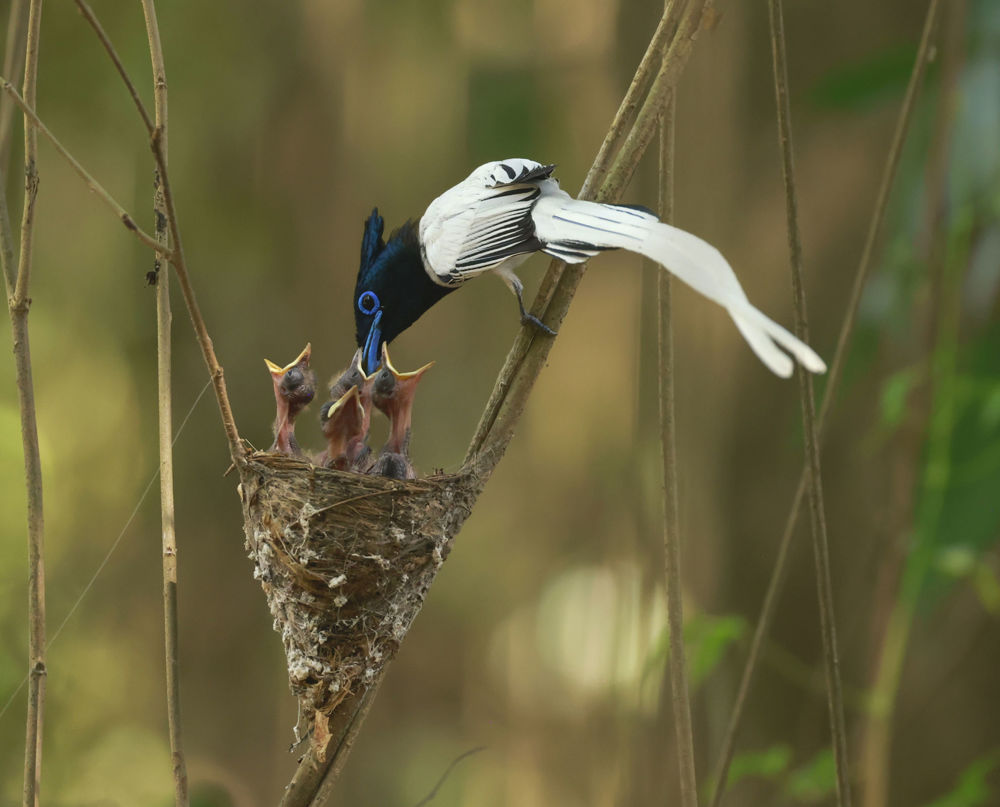
The fabulous Indian Paradise-Flycatcher gave magical views—Photo: Andrew Whittaker
The glowing orange dawn greeted us as we peacefully punted across the Narayani River, listening to the magical chorus as the forest awoke. We boarded our safari vehicle to begin exploring Chitwan’s impressive sal forests, remote marshes, and grasslands. Our enjoyable safaris produced Wild Boar, Indian Hog Deer, and spectacular studies of many giant Greater One-horned Rhinos, one even with a calf. We found many fresh tiger tracks. Without a doubt, though, our mammal highlight was a massive female Sloth Bear and cub—and we cannot forget the inquisitive Terai Gray Langurs.
Birding produced a plethora of cool species, too, far too many to list here, but all carefully tallied in our eBird trip report. A visit to the pioneering vulture restaurant was a superb success. Before we even entered the blind, a Brown Fish-Owl with an eel and a charming party of Rufous-necked Laughingthrushes distracted us. Once we were inside and the carcass was deposited, hordes of vultures immediately descended from everywhere, and within minutes the flock was up to some 150 vultures. White-rumped Vultures were the commonest member of the feeding frenzy, and critically endangered Slender-billed Vultures were a real prize. The smaller Red-headed and Egyptian vultures kept to the edges, while the huge Himalayan Griffon was clearly the boss of them all.
Always a highlight was our afternoon birding walk to visit those gentle giants, the Asian Elephants. Our stroll ended in a truly memorable sundowner on the beach. Nepal is a country that captivates the imagination and offers a true sense of serenity.
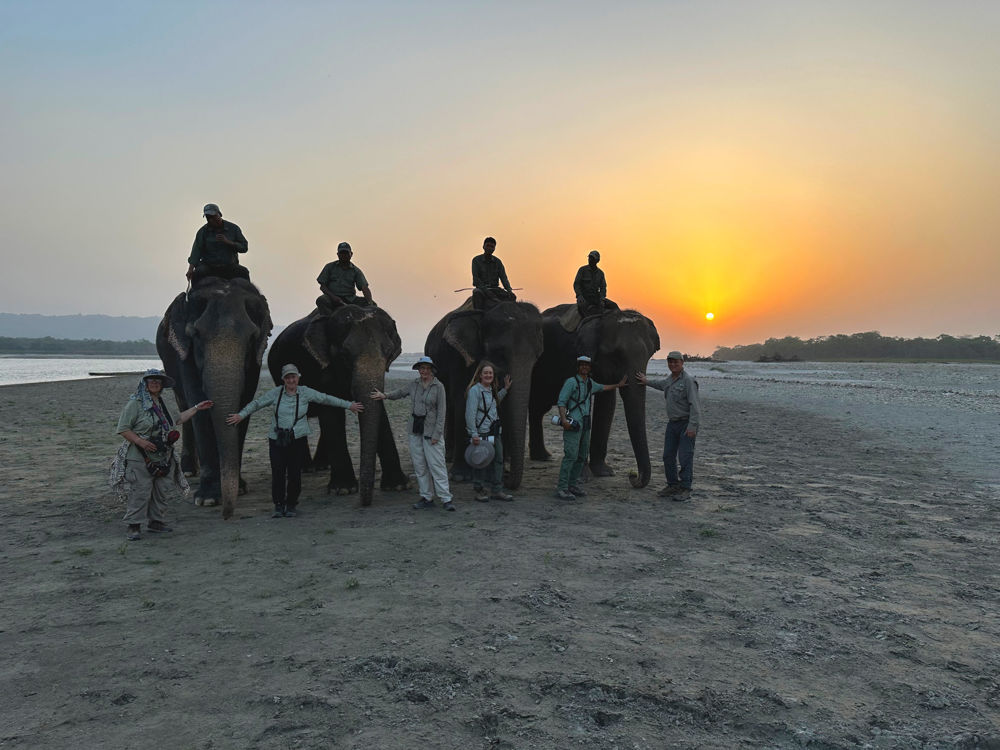
Gentle giants at sunset, the Asian Elephants—Photo: Andrew Whittaker
What a magical adventure we shared, from the mighty Himalayas to the rich lowland forests! Som, Badri, and I greatly enjoyed sharing Nepal’s bountiful wildlife with our super-fun group. I hope we cross paths again on one of my many VENT tours worldwide.
FAVORITE BIRDS OF THE TRIP (as voted by the group):
1. FIRE-TAILED SUNBIRD
2. INDIAN PARADISE-FLYCATCHER
3. PLUM-HEADED PARAKEET
4. SATYR TRAGOPAN
5. SCARLET MINIVET
6. INDIAN COURSER
7. ROSY MINIVET/INDOCHINESE ROLLER/GREATER FLAMEBACK
A complete list of the birds recorded on our tour can be found at: eBird.org/tripreport/388113

